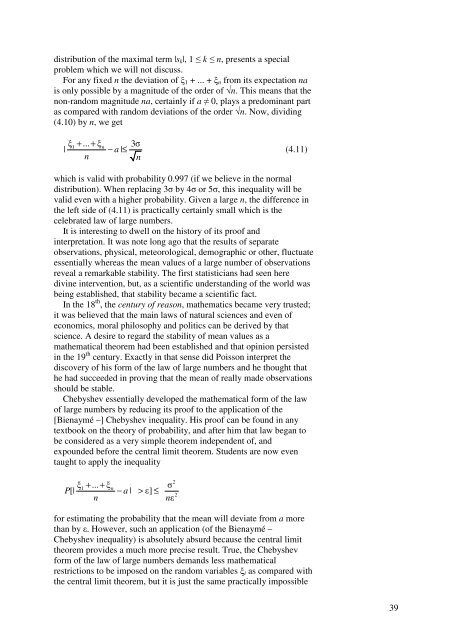1 Studies in the History of Statistics and Probability ... - Sheynin, Oscar
1 Studies in the History of Statistics and Probability ... - Sheynin, Oscar
1 Studies in the History of Statistics and Probability ... - Sheynin, Oscar
Create successful ePaper yourself
Turn your PDF publications into a flip-book with our unique Google optimized e-Paper software.
distribution <strong>of</strong> <strong>the</strong> maximal term |s k |, 1 ≤ k ≤ n, presents a specialproblem which we will not discuss.For any fixed n <strong>the</strong> deviation <strong>of</strong> ξ 1 + ... + ξ n from its expectation nais only possible by a magnitude <strong>of</strong> <strong>the</strong> order <strong>of</strong> √n. This means that <strong>the</strong>non-r<strong>and</strong>om magnitude na, certa<strong>in</strong>ly if a ≠ 0, plays a predom<strong>in</strong>ant partas compared with r<strong>and</strong>om deviations <strong>of</strong> <strong>the</strong> order √n. Now, divid<strong>in</strong>g(4.10) by n, we getξ + ... + ξ 3σ− ≤ (4.11)nn1n| a |which is valid with probability 0.997 (if we believe <strong>in</strong> <strong>the</strong> normaldistribution). When replac<strong>in</strong>g 3σ by 4σ or 5σ, this <strong>in</strong>equality will bevalid even with a higher probability. Given a large n, <strong>the</strong> difference <strong>in</strong><strong>the</strong> left side <strong>of</strong> (4.11) is practically certa<strong>in</strong>ly small which is <strong>the</strong>celebrated law <strong>of</strong> large numbers.It is <strong>in</strong>terest<strong>in</strong>g to dwell on <strong>the</strong> history <strong>of</strong> its pro<strong>of</strong> <strong>and</strong><strong>in</strong>terpretation. It was note long ago that <strong>the</strong> results <strong>of</strong> separateobservations, physical, meteorological, demographic or o<strong>the</strong>r, fluctuateessentially whereas <strong>the</strong> mean values <strong>of</strong> a large number <strong>of</strong> observationsreveal a remarkable stability. The first statisticians had seen herediv<strong>in</strong>e <strong>in</strong>tervention, but, as a scientific underst<strong>and</strong><strong>in</strong>g <strong>of</strong> <strong>the</strong> world wasbe<strong>in</strong>g established, that stability became a scientific fact.In <strong>the</strong> 18 th , <strong>the</strong> century <strong>of</strong> reason, ma<strong>the</strong>matics became very trusted;it was believed that <strong>the</strong> ma<strong>in</strong> laws <strong>of</strong> natural sciences <strong>and</strong> even <strong>of</strong>economics, moral philosophy <strong>and</strong> politics can be derived by thatscience. A desire to regard <strong>the</strong> stability <strong>of</strong> mean values as ama<strong>the</strong>matical <strong>the</strong>orem had been established <strong>and</strong> that op<strong>in</strong>ion persisted<strong>in</strong> <strong>the</strong> 19 th century. Exactly <strong>in</strong> that sense did Poisson <strong>in</strong>terpret <strong>the</strong>discovery <strong>of</strong> his form <strong>of</strong> <strong>the</strong> law <strong>of</strong> large numbers <strong>and</strong> he thought tha<strong>the</strong> had succeeded <strong>in</strong> prov<strong>in</strong>g that <strong>the</strong> mean <strong>of</strong> really made observationsshould be stable.Chebyshev essentially developed <strong>the</strong> ma<strong>the</strong>matical form <strong>of</strong> <strong>the</strong> law<strong>of</strong> large numbers by reduc<strong>in</strong>g its pro<strong>of</strong> to <strong>the</strong> application <strong>of</strong> <strong>the</strong>[Bienaymé –] Chebyshev <strong>in</strong>equality. His pro<strong>of</strong> can be found <strong>in</strong> anytextbook on <strong>the</strong> <strong>the</strong>ory <strong>of</strong> probability, <strong>and</strong> after him that law began tobe considered as a very simple <strong>the</strong>orem <strong>in</strong>dependent <strong>of</strong>, <strong>and</strong>expounded before <strong>the</strong> central limit <strong>the</strong>orem. Students are now eventaught to apply <strong>the</strong> <strong>in</strong>equalityP2ξ + ... + ξ σ− > ≤nnε1n[| a | ε]2for estimat<strong>in</strong>g <strong>the</strong> probability that <strong>the</strong> mean will deviate from a morethan by ε. However, such an application (<strong>of</strong> <strong>the</strong> Bienaymé –Chebyshev <strong>in</strong>equality) is absolutely absurd because <strong>the</strong> central limit<strong>the</strong>orem provides a much more precise result. True, <strong>the</strong> Chebyshevform <strong>of</strong> <strong>the</strong> law <strong>of</strong> large numbers dem<strong>and</strong>s less ma<strong>the</strong>maticalrestrictions to be imposed on <strong>the</strong> r<strong>and</strong>om variables ξ i as compared with<strong>the</strong> central limit <strong>the</strong>orem, but it is just <strong>the</strong> same practically impossible39









